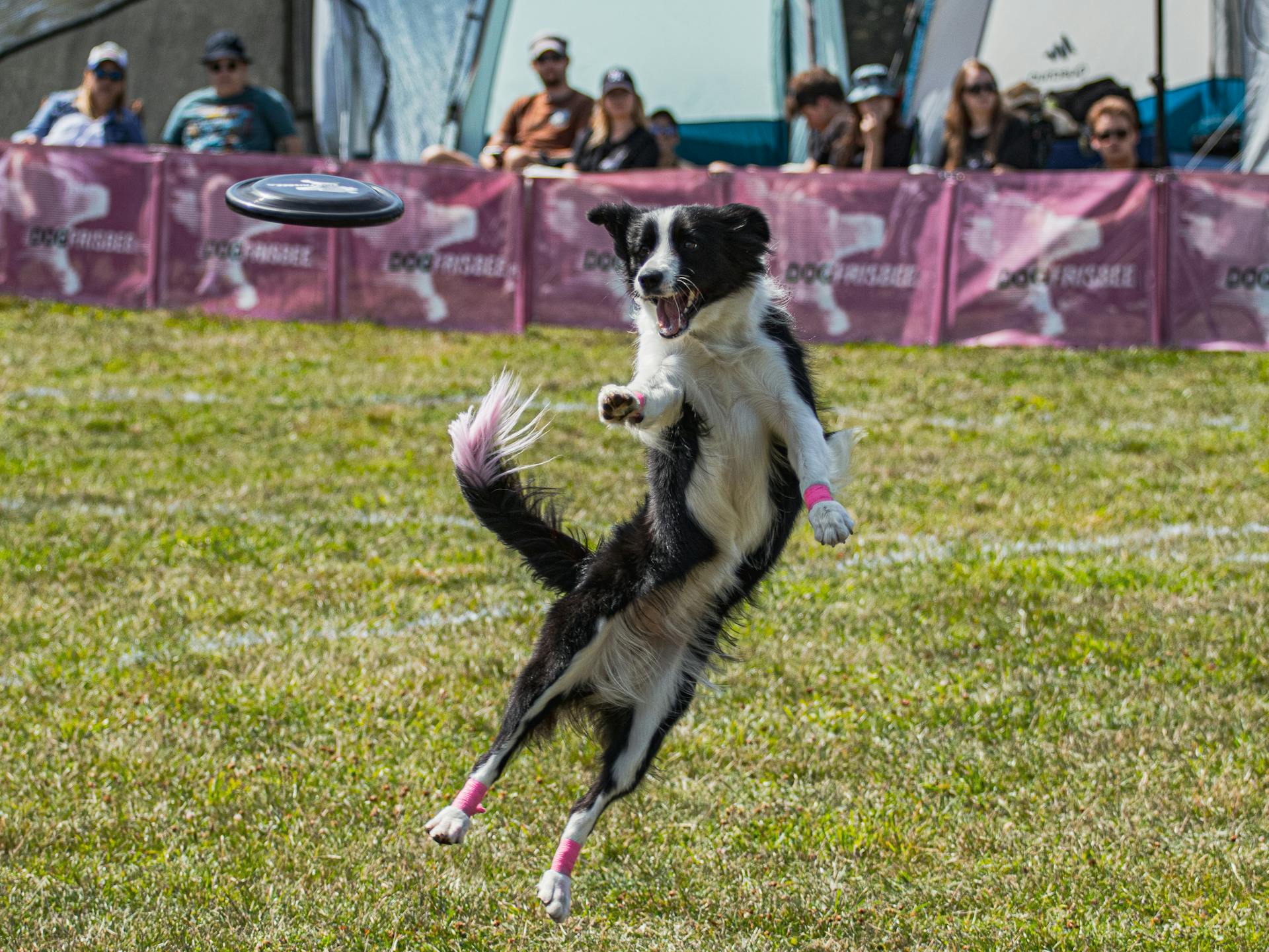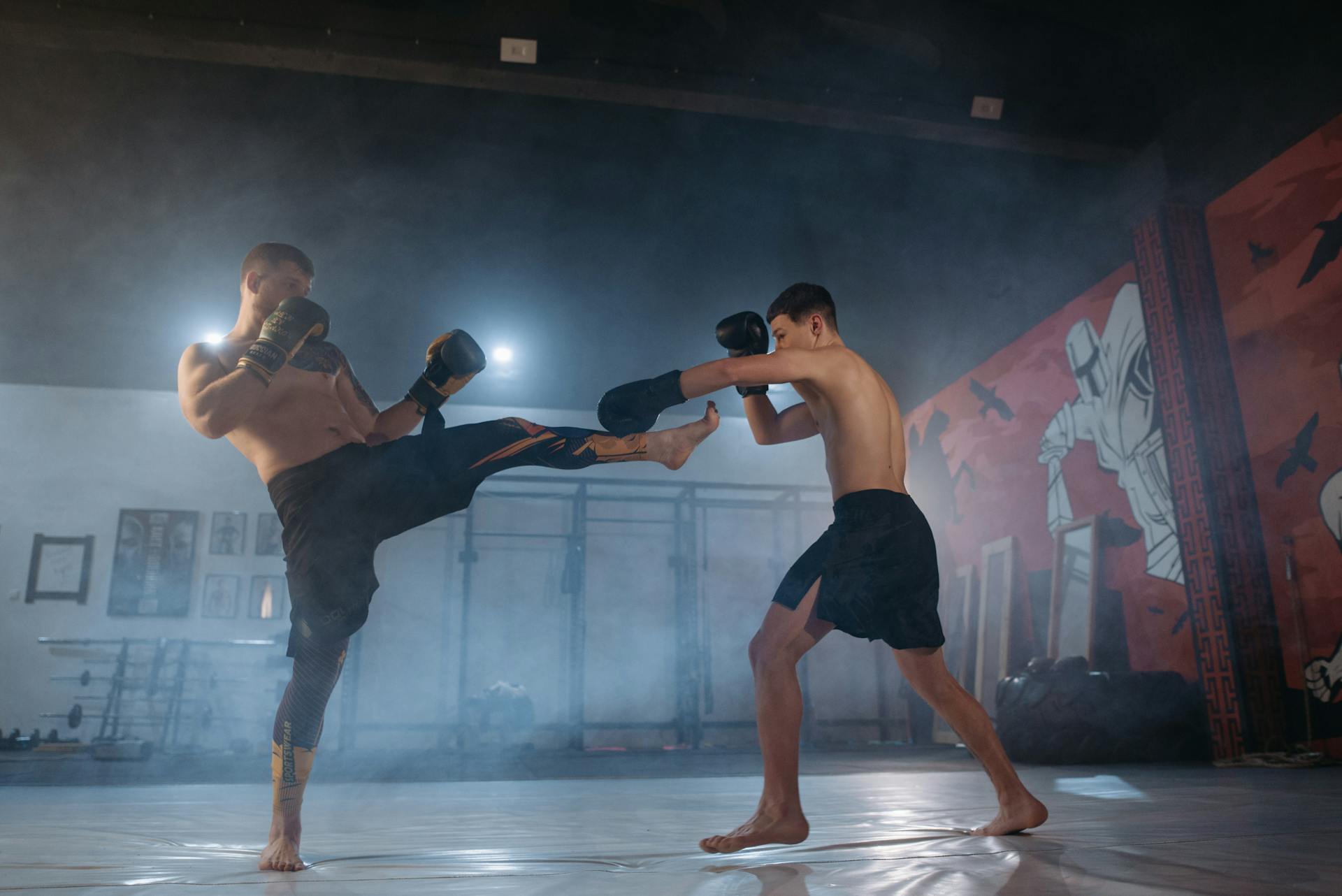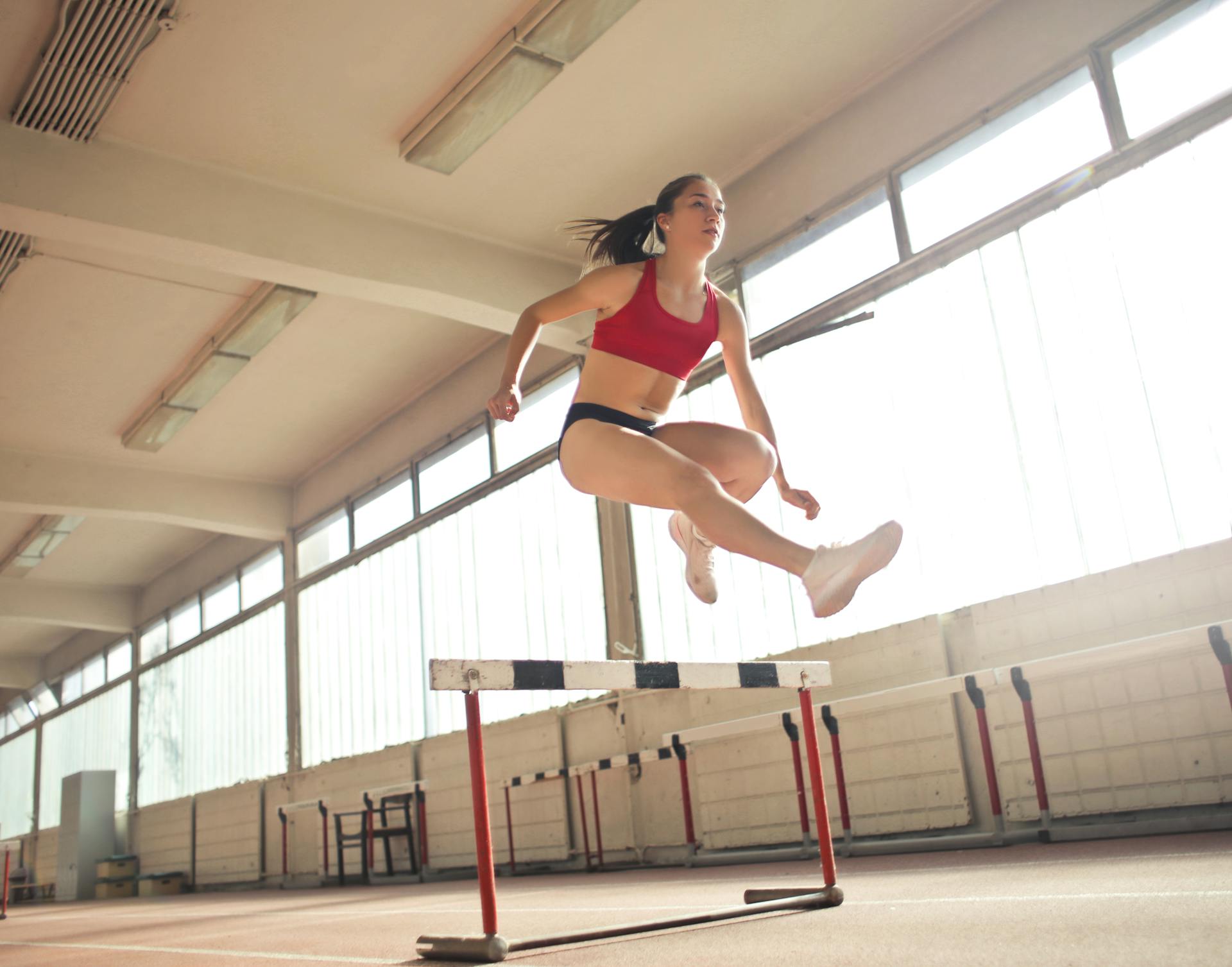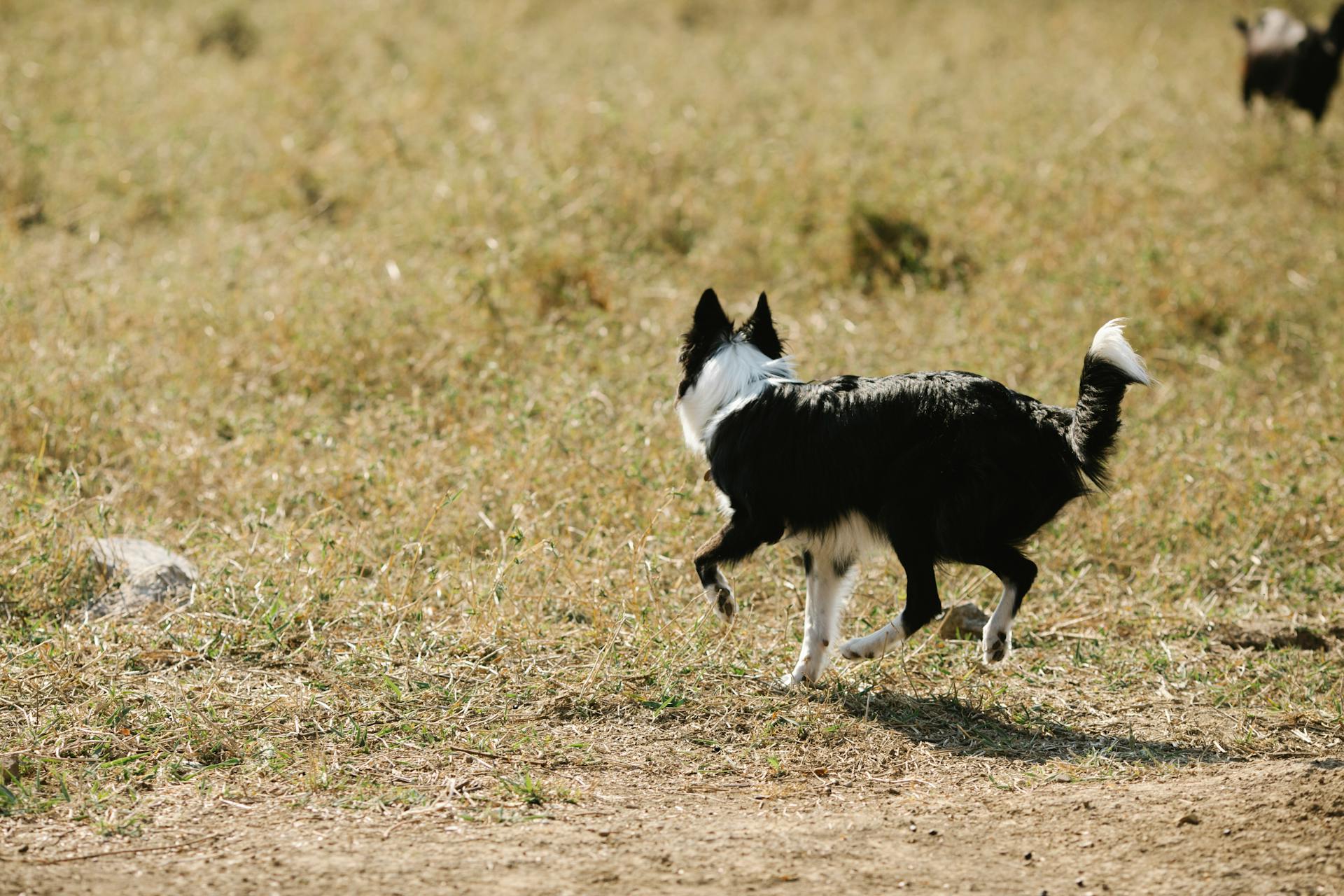
Dog agility training at home is a game-changer for both you and your furry friend.
Not only can it be a fun way to bond with your dog, but it also provides a great workout for both of you. By incorporating agility training into your daily routine, you can improve your dog's physical fitness and mental well-being.
Studies have shown that dog agility training can help reduce anxiety and stress in dogs, while also increasing their confidence and focus.
With a little creativity and some basic equipment, you can set up a mini agility course in your own backyard.
DIY Equipment
Creating your own dog agility equipment at home is a fun and budget-friendly way to get started with agility training. You can use items like PVC pipes, broom sticks, and laundry baskets to create obstacles like jumps and tunnels.
You'll need a few simple household items to get started, such as buckets, broomsticks, cardboard boxes, blankets, and garden stakes. These items can be used to make jumps, tunnels, and weave poles.
Readers also liked: Diy Dog Agility Jumps
Dog agility courses typically have between 14 and 20 obstacles, so start with the basics and gradually add more complex obstacles as you and your dog become more confident. Begin with jumps, as dogs love to jump and it's a great way to build confidence.
Here are some DIY equipment ideas to get you started:
- Jump: Use two plastic laundry baskets with multiple holes on all sides and a broom to create a jump.
- Tunnel: Use a large cardboard box to create a tunnel.
- Weave poles: Use garden stakes and a blanket to create weave poles.
Remember, the key to successful DIY agility training is to keep it fun and not stress about making mistakes. Be patient and work in small steps, and you and your dog will be agility training in no time!
Jumps and Obstacles
Jumps are a fun and popular part of dog agility training, and you can easily make them with everyday household items.
To create jumps, start by balancing a broomstick across two buckets or flower pots to create a simple hurdle. This setup allows the stick to fall off if your dog runs into it, keeping them safe.
Make sure to get your dog used to jumping over a bar by creating a simple hurdle with a broomstick and buckets. This will help them learn to jump on their own.
You can also use a tire jump, which can be made by tying a bike tire to a tree branch or creating a PVC frame to hold a ring made from pool noodles. This obstacle is a great way to challenge your dog.
When practicing jumps in nature, use cinderblocks to create a steady jumping obstacle. The jump itself should be lightweight to prevent injuries, so use strips of wood, rope, or thin plastic pipe.
Jumping through a hoop is a classic trick that starts with getting your dog to walk through the hoop and gradually raises the hoop over time. Always err on the side of "lower" rather than "higher" to ensure your dog doesn't get hurt.
An agility ladder is a great way to teach your dog to pick up their feet as they walk over each rung. You can place a regular ladder on a soft non-skid area to make it safe for your dog.
Check this out: Agility Dog Jump Heights
Hurdles are simply obstacles where your dog will jump over a horizontal pole, and you can make them using PVC structures or other materials. Just make sure they're about chest height for your dog.
Remember to always keep safety and your dog's abilities in mind when creating jumps and obstacles for them to practice.
Training Benefits Humans
Agility training is not just good for your dog, it's also a great way to improve your own physical and mental well-being. You'll get a workout while having fun with your dog.
As the Alternative Canine Training Team notes, agility training is a sport where you direct your dog through a pre-set obstacle course within a certain time limit. This can be a great way to challenge yourself and improve your communication skills with your dog.
You'll have the opportunity to bond with your dog while exercising together, which can lead to a more relaxed and content relationship. Dogs that participate in agility training tend to be less fearful and anxious, making them easier to handle in various situations.
Check this out: National Dog Show 2023 Great Dane
Dogs of all breeds and ages can benefit from agility training, but it's essential to start with basic commands and socialization. If you're new to agility training, consider enrolling in a group class to learn from experienced trainers and socialize your dog with other dogs and people.
Safety should always be your top priority when engaging in agility training with your dog. Be sure to consult with your veterinarian before beginning any new exercises to ensure your dog can handle them physically and emotionally.
Exercises and Routines
Exercise is a crucial part of dog agility training, and it's not just your dog that gets a workout - you'll be getting one too. You can modify the agility course to honor your needs, so don't worry if you're not as agile as you used to be.
Having fun together is a key benefit of agility training. It's not just about the exercise or the bonding time, but about enjoying each other's company while doing something exciting.
Suggestion: It's Your Choice Dog Training
Bonding time is essential for a strong relationship with your dog. Agility training provides an opportunity to spend quality time with your furry friend, which can lead to a more relaxed and content dog.
Exercise and bonding time combined make for a more obedient dog. As your dog becomes more relaxed and content, they'll be less likely to get anxious or fearful in new situations.
You can start creating a DIY agility course at home using things you already have or find online. The #1 rule is to remember that agility training is all about fun, so don't stress and be patient.
Here are some fun DIY agility training exercises to try at home:
- Tunnel runs using cardboard boxes
- Weave poles using broom handles or PVC pipes
- Jump hurdles using books or small obstacles
- contact obstacles using a small ramp or a couch cushion
Remember to work in baby steps and set small expectations. Prepare to delight in any bigger learning that may happen along the way.
Frequently Asked Questions
What age should a dog start agility?
Dogs typically start agility training between 12-18 months of age, once they've reached full physical maturity. However, the ideal start time may vary depending on your dog's breed and individual development
How long does it take a dog to learn agility?
Typically, it takes 1-2 years for a well-behaved dog to learn agility, depending on the handler's experience. Starting early with a puppy can significantly shorten this learning curve
How do I get my dog to start agility?
Start your dog's agility journey with a weekly class or backyard training, building jumps and obstacles to get them accustomed to the activity
Sources
- https://www.animalbehaviorcollege.com/blog/lifestyle/fun/dog-agility-equipment-diy/
- https://www.dailypaws.com/dogs-puppies/dog-training/agility-competitive/diy-dog-agility-course
- https://sitstay.com/blogs/good-dog-blog/diy-dog-agility-course
- https://woollywolf.co/en-en/blogs/blog/8-dyi-dog-agility-ideas
- https://alternativecaninetraining.com/2021/04/29/5-fun-agility-training-exercises-for-your-dog/
Featured Images: pexels.com


